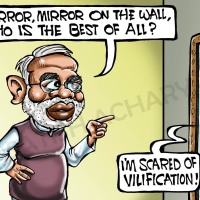In the Bangalore edition of this paper published on October 15, 2012, there was a story on sexual assault on a law student, and some of our readers were alert to notice that the report was not sensitive enough. Though the report refrained from naming the victim, a good practice not to doubly penalise the victim as identifying the victim can lead to unwarranted stigma, it did give away some other details which can be construed as identifying clues. This was indeed a mistake.
When this was pointed out, the Bangalore editorial team swung into action. The story was recast in an appropriate manner in the Internet edition. The Hindu’s Bangalore Bureau Chief, Parvathi Menon, responded immediately: “An inexperienced cub reporter, lax gate-keeping on a lean Sunday night, and a biased report the next morning. The reader has raised all the right questions on how to (or how not to) report sexual assaults. We are usually careful and gender sensitive in such matters — scrupulously avoiding any pointers that could identify the victim, and I am deeply distressed that such a thing happened. We apologise for this slip-up, and it is a lesson learnt.”
This raises the larger question of gender-sensitive reporting. The United Nations Fourth World Conference on Women held in Beijing in 1995 is a watershed on reporting gender in media. The conference came out with two strategic objectives for media: a) Increase the participation and access of women to expression and decision-making in and through the media and new technologies of communication, and b) promote a balanced and non-stereotyped portrayal of women in the media. A diverse team of women journalists, writers, activists, academics and media scholars worked on a number of manuals, glossaries and media tool kits to help journalists to deploy what is now popularly called the gender lens in their reporting and analysis.
Since the Beijing Declaration, the quality of reporting gender has vastly improved, and the presence of women in our newsrooms has dramatically increased. Yet, gender-sensitive reporting has not become a matter of routine. There is a huge gap between our desire to have a fair gender representation and practice. The latest study done by the U.K.-based journalists’ association, Women In Journalism, brings out this stark reality. It looked at bylines, photos and did content analysis of leading British dailies. The findings do not make us feel proud.
The study says: “we found that 78% of all front page bylines were male; 22% were female. We also counted separately the gender of the journalist whose name appeared first on the lead story, and the results here were similar: 81%, male; 19%, female.” It further explains, through meticulous empirical listing, that men dominate even the content in many ways. According the study, “of all those quoted or mentioned by name in the lead stories, 84% were men, and just 16% women.” (http://womeninjournalism.co.uk/wp-content/uploads/2012/10/Seen_but_not_heard.pdf)
One of significant differences the finding brings out is the role of men and women in news stories. It found that three-quarters of “experts” were men and 79 per cent of “victims” were women. It further states: “the most interesting findings here are that while nearly a fifth (19%) of women quoted or mentioned were ‘victims,’ hardly any men fell into this category (2%); and that men featuring in news stories are significantly more likely than women to be ‘experts’ (82% of total men, compared with 61% of total women).”
A leading international expert on ethical journalism and Director of Ethical Journalism Network, Aidan White, says: “When Australia’s Prime Minister Julia Gillard vigorously rounded on Opposition leader Tony Abbott last week accusing him of hypocrisy and misogyny she was widely praised, but not by the mainstream media which said she was diverting attention from problems of sexism within her own party. However, this was a predictable media response say observers who complain that when it comes to bias, discrimination and gender stereotypes journalism is part of the problem.”
As White rightly points out, changing this will require a radical shift in the male mindset in all areas of public life but particularly in journalism. And at The Hindu, we are trying to institutionalise this radical shift.
readerseditor@thehindu.co.in
Related articles
- Where are all the women in journalism? (sarah-graham.co.uk)
- Simons: how media perpetuate women’s silence (crikey.com.au)
- Is rape victim anonymity sufficiently well-enforced? (thefword.org.uk)










